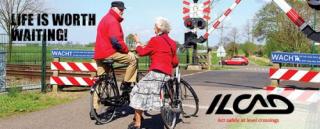Operation Lifesaver, Inc. offers safety tips during international crossing awareness observance
WASHINGTON, DC, June 9, 2016 – U.S. rail safety education nonprofit Operation Lifesaver, Inc.(OLI) will participate in the eighth annual observance of International Level Crossing Awareness Day (ILCAD) June 10-11 as one of 40 countries calling worldwide attention to the need for safe behavior near tracks and trains.
“Operation Lifesaver USA is proud to observe International Level Crossing Awareness Day to focus global attention on the life-or-death issue of safe behavior at railroad crossings,” said OLI President and CEO Bonnie Murphy. “This year’s ILCAD outreach will focus on crossing safety for senior citizens and people with sensory and mobility restrictions, and Operation Lifesaver will also extend our efforts to a broader audience to spread these critical, lifesaving messages as widely as we can.”
Many Operation Lifesaver state programs and partners will participate in activities in conjunction with ILCAD, including crossing safety enforcement blitzes; “Chalk One Up for Safety” drawing contests featuring rail safety messages and social media sharing; Officer on the Train events; and rail safety information booths at popular tourist attractions.
International Level Crossing Awareness Day began in 2009 in Europe to highlight the need for public education on railway safety issues.
“Our continuing See Tracks? Think Train! safety education campaign, developed in conjunction with the Association of American Railroads, encourages drivers and pedestrians to make safety an automatic habit near train tracks,” said Murphy. “This international partnership to raise awareness of rail safety – on ILCAD, and every day – supports our shared goal to eliminate deaths and injuries around tracks and trains throughout our communities.”
Operation Lifesaver offers these tweetable safety tips for all drivers and pedestrians, including those with sensory and mobility restrictions:
2. Whenever you approach a highway-rail grade crossing, always expect a train. #ILCAD
3. Remember that trains don’t follow set schedules and may approach from either direction.
7. Listen carefully and look both ways to confirm that a train is not approaching before proceeding.
12. Never stop on the tracks, even if a train is not in sight. #ILCAD
About Operation Lifesaver - Operation Lifesaver is a nonprofit public safety education and awareness organization dedicated to reducing collisions, fatalities and injuries at highway-rail crossings and preventing trespassing on or near railroad tracks. A national network of trained volunteers provides free presentations on rail safety and a public awareness campaign, “See Tracks? Think Train!” equips the general public with tips and statistics to encourage safe behavior near the tracks. Learn more at http://www.oli.org; follow OLI on Facebook, Twitter, Pinterest and Instagram.
